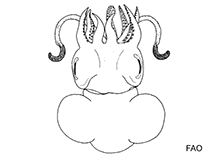Rossia brachyura Verrill, 1883
Mandar um arquivo com seu (sua) Fotos
Imagem do Google | No image available for this species;
drawing shows typical species in Sepiolidae.
Imagem do Google | No image available for this species;
drawing shows typical species in Sepiolidae.
Classification / Names Common names | Synonyms | CoL | ITIS | WoRMS
Cephalopoda | Sepiida | Sepiolidae | Rossiinae
Environment: milieu / climate zone / depth range / distribution range Ecologia
Demersal. Tropical
Distribuição Países | Áreas FAO | Ecossistemas | Ocorrências | Introduções
Western Central Atlantic: Greater and Lesser Antilles.
Length at first maturity / Tamanho / Peso / Idade
Maturity: Lm ? range ? - ? cm
Life cycle and mating behavior Maturidade | Reprodução | Desova | Ovos | Fecundidade | Larvas
Members of the class Cephalopoda are gonochoric. Male and female adults usually die shortly after spawning and brooding, respectively. Mating behavior: Males perform various displays to attract potential females for copulation. During copulation, male grasp the female and inserts the hectocotylus into the female's mantle cavity where fertilization usually occurs. Life cycle: Embryos hatch into planktonic stage and live for some time before they grow larger and take up a benthic existence as adults.
Referência principal
Referências | Coordenador | Colaboradores
Jereb, P. and C.F.E. Roper (eds.). 2005. (Ref. 1695)
Status na Lista Vermelha da IUCN (Ref. 130435: Version 2024-1)
Dados insuficientes (DD) ; Date assessed: 28 March 2009
Status no CITES (Ref. 108899)
Not Evaluated
CMS (Ref. 116361)
Not Evaluated
Perigo para os humanos
Uso pelos humanos
| FishSource |
Ferramentas
Mais informação
Trophic Ecology
Itens alimentares
Dieta
Consumo alimentar
Ração
Predadores
Dieta
Consumo alimentar
Ração
Predadores
Ecology
Population dynamics
Crescimento
Idade/Tamanho
Comprimento-peso
Comprimento-comprimento
Frequências de comprimento
Mass conversion
Recrutamento
Abundância
Idade/Tamanho
Comprimento-peso
Comprimento-comprimento
Frequências de comprimento
Mass conversion
Recrutamento
Abundância
Life cycle
Distribution
Human Related
Perfil para aquacultura
Stamps, Coins Misc.
Stamps, Coins Misc.
Outreach
Taxonomy
References
Fontes da internet
BHL | BOLD Systems | CISTI | DiscoverLife | FAO(Publication : search) | Fishipedia | GenBank (genoma, nucleotídeo) | GloBI | Gomexsi | Google Books | Google Scholar | Google | PubMed | Árvore da vida | Wikipedia (Ir para, procura) | Registro zoológico
Estimates based on models
Categoria de preço
(Ref. 80766):
Unknown.



